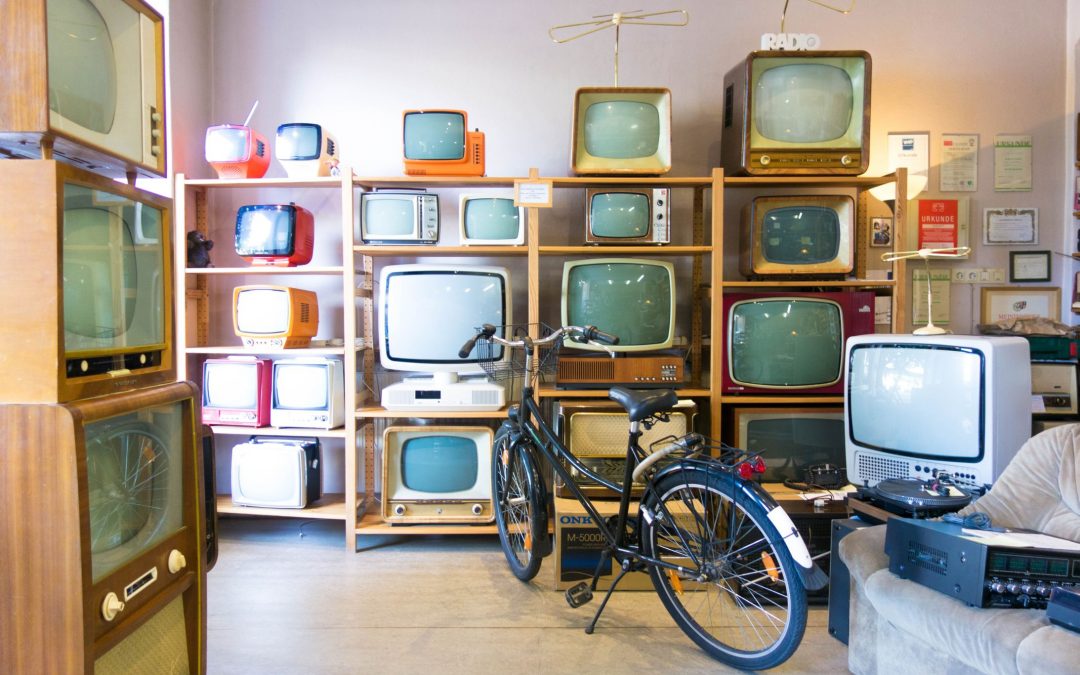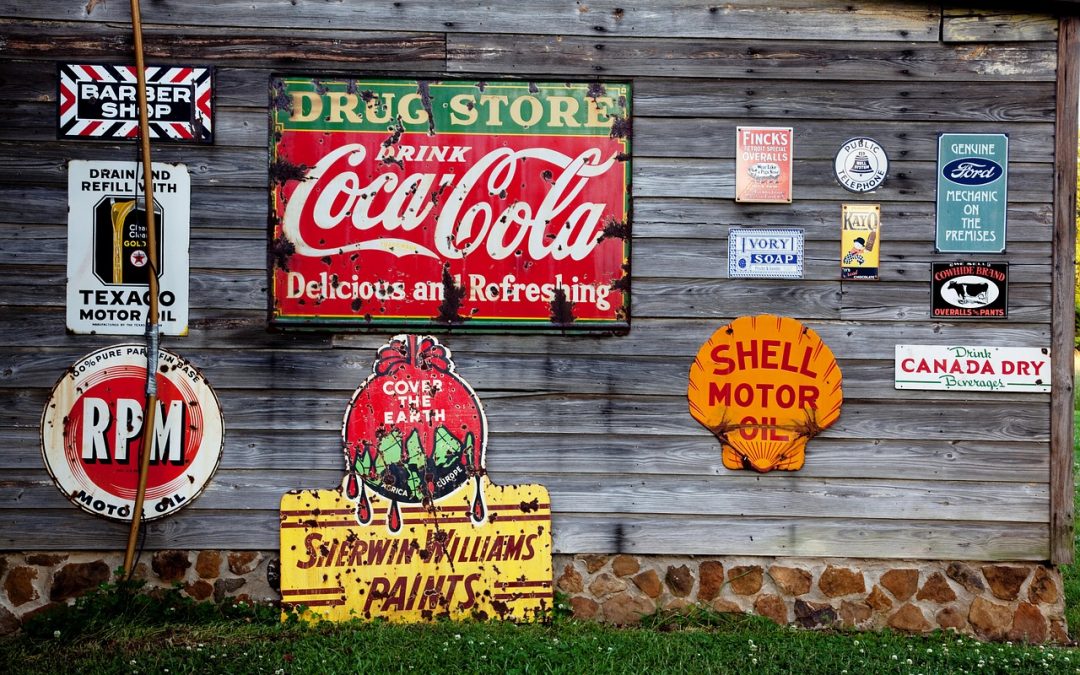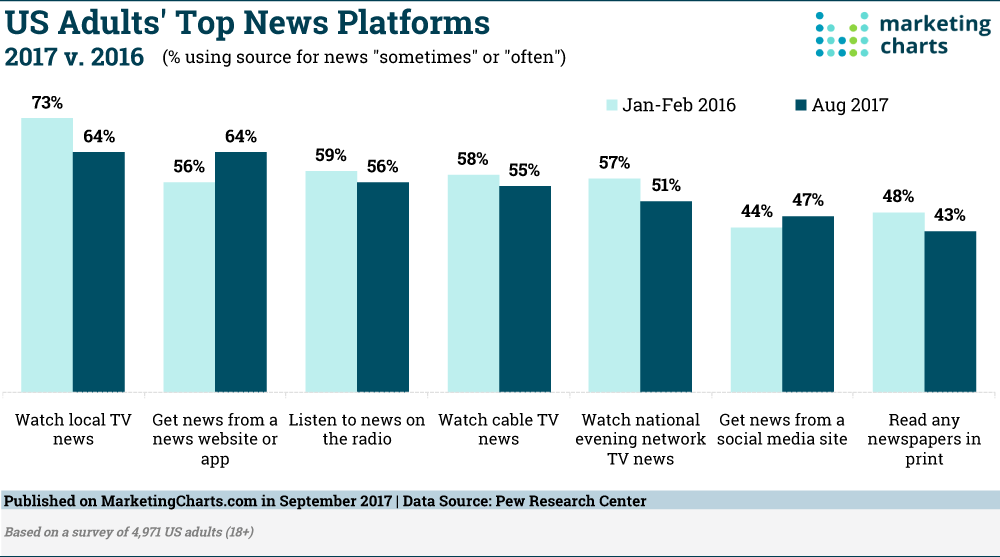
by Scott Howard | May 24, 2018 | Marketing and Advertising Insights, ScLoHo's Collective Wisdom, The Not-So-Secret Writings of ScLoHo, Uncategorized, WOWO Fort Wayne Radio Advertising with Scott Howard
As we head into the unofficial summer season of June, July and August, the three months between Memorial Day and Labor Day, I want to address a headline I saw again and give you an insiders perspective on The Decline of Mass Media.
Why talk about it now? Well, television viewing habits in years past were different during summer time, with the major networks showing summer reruns instead of new episodes. But hang on because I’m getting ahead of myself.
What is mass media anyway? Perhaps traditional media is a better term. Television, Radio, Newspapers and Magazines are the traditional media that have been the mainstay since the 1950’s and before.
Newspapers are continuing to struggle. Lay offs and shut downs have been occurring for nearly two decades, due to the rise of the internet. One story I read this month blamed the owners for cutting staffs.
The Denver Post cut the newsroom from 184 journalists to 99, according to the story. Other cuts at other newspapers were also harsh. 73 reporters down to 10 while another paper went 45 to 12 journalists. Locally in Fort Wayne, the afternoon paper ceased publication, and instead gets one sheet in the morning paper and an online edition. I saw friends of mine in the newspaper business in town leave either on their own or due to cutbacks. I was once tempted about 8 years ago to work for their online division but am grateful I stayed put.
The company I work, Federated Media sold the one newspaper they owned a couple years ago because it was nearly impossible to be profitable.
When I say the internet is the reason for the decline in print, it’s really a combination of things related to the internet.
Accessibility for one. 20 years ago most of us owned a desktop computer with a dial-up modem at home, if we had a home computer. 12 years ago laptops took over as the primary personal computer device. And did you realize that the first iPhone debuted in 2007, ushering in the smartphone revolution?
Online Content is the other contributing factor. No need to wait for the morning paper to check the weather or the score. Newspapers have tried to replace their dwindling subscriber numbers with paywall subscriptions, but the math doesn’t work. If you don’t have the readers, the advertisers will also go away and the decline has been going on for too long.
Declines in the magazine publishing industry are similar. What seems to have survived in print is specialized publications. Smaller but targeted readership than mass media.
Another way the internet has changed the media is the television industry. The New York Times featured a story that I read online about the future of broadcasting: Why Traditional TV Is in Trouble.
Here’s a few quotes:
Ratings are on the decline, especially among young people, some of whom don’t even own televisions. It’s hard to keep up with the many devices and apps people now use to watch shows. And there is a host of material from Silicon Valley that is competing for viewers’ attention, including Google’s YouTube, Facebook and Netflix. It all adds up to a precarious situation for broadcast TV.
Advertising on TV has long been the best way for marketers to reach a large number of people at one time. And it is still a formidable medium. But cracks are showing.
and:
The hottest shows on TV networks — which command the highest ad prices — are attracting older viewers, which is a challenge for brands that want to reach millennials and teens. For instance, this season’s top-rated show, the revival of “Roseanne,” has a median viewer age of 52.9 years. The network show with the lowest median age is “Riverdale” on the CW, at 37.2.
The TV networks will be able to survive by reinventing themselves much like radio stations did when television became a media force last century. But the local TV stations? My advice if you want to reach anyone younger than Baby Boomers, good luck. All of my kids are in their 30’s and none of them are watching broadcast TV, some don’t even own a television. They get their video content online. Even my wife and I watch just as much video content on something other than a TV or if we do, often it’s days later and the local ads are not even seen.

So what is taking the place of traditional broadcast TV as a mass media?
Netflix, Amazon Prime Video, YouTube, to name a few. Alternatives to cable like Sling, Hulu and Roku. These are all offering the best of both worlds for advertisers. You get to reach people watching video content but you get to target your ads to specific audiences, one of the technical marvels of the internet.
Here’s a quote from a newsletter I received from Google:
More than half of 18 to 49-year-olds in the U.S. either don’t watch a lot of TV or do not subscribe to TV. But that doesn’t mean TV content and TV screens are on their way out. In fact, the TV screen is the fastest growing screen for YouTube content, with 70% growth in the last two years.
Let me address the radio broadcasting industry too. It was the first broadcast mass media and WOWO radio, the station I work for is over 90 years old. There are two categories of traditional broadcast radio stations these days, and I’m not talking about AM and FM. The two categories I am referring to are talk based programming and music based programming.
Radio broadcasting started out with network radio shows from NBC, CBS, ABC and the Mutual Broadcasting System and eventually they evolved to what we have today.
In Fort Wayne, Indiana, there are 37 radio stations within close listening range. Some are duplicates of the same programming on different signals, like WOWO 1190 AM is the same as WOWO 107.5 FM, so let’s say there are 25 separate and individual choices. This is also a way of targeting your advertising. The best local radio stations keep an emphasis on local content, stuff you can’t get by listening to Spotify or Pandora.
Federated Media has 6 stations in Fort Wayne, four are music based, two are talk. I work for the talk stations, WOWO and our ESPN affiliated station. Both offer a combination of local and national programs. There are specific characteristics of WOWO listeners that help me determine if advertising on WOWO would be a good idea. Want to reach grown-ups? Let’s talk. Want to reach teenagers? I’ll connect you with someone who works for one of our music stations.
Not all radio stations and radio broadcasting companies are the same. Overall radio listenership has remained pretty steady for the past decade. Over 90% of everyone age 12 and older listens every week. However smart radio stations and companies are staying ahead of the trends that we see going on around us.
For years, radio stations like WOWO offered a way for you to listen via the internet. Go to WOWO.com and click on the listen now tab and you can stream WOWO on your computer. There are plenty of apps that offer access to radio stations like WOWO, and some people listen to WOWO via the WOWO app itself.
2018 however is the break thru year for Alexa and Google Home smart speaker systems. We are seeing a resurgence in radio listening simply by telling the smart speakers to play WOWO and poof, there’s Pat Miller in the afternoon or Charly Butcher in the morning, in your kitchen, just like 40 years ago when I was a kid and my parents had clock radios in their house.
One last way radio stations like WOWO are staying on top of the trends is podcasting. WOWO and our other Federated Media stations share both content from our live shows online in podcast form, but also we have some podcast only shows that are available via iTunes or what ever your favorite podcasting player is. Podcasting is huge and we can connect businesses to podcast listeners too.
The title of this today was The Decline Of Mass Media. As I’ve laid out what’s going on in print and broadcasting in response to the web connected world we live in, I hope you see as I do, these are exciting times. The traditional mass medias that are adapting are going to done fine while the others struggle and will be a mere shadow of their former selves.
Fortunately, I get to work with a company that continues to be on the leading edge and I get to offer advertising and marketing solutions that work using WOWO radio and our digital marketing division of Federated Media.
Want to see how I can help your business grow this year and next? Contact me.
One final piece that I’m going to share because it was posted on LinkedIn by Ben Saurer, WOWO radio’s General Sales Manager that demonstrates how WOWO truly is a leader. Ben’s job is to hire, coach and lead an advertising sales team. Quite frankly, most media companies struggle with this, but as you will see, WOWO is different, in a good way. Here’s what an excerpt from what Ben wrote:
All my people earn above the industry average. Client retention is high. Everyone on my staff is generating more revenue than last year. We’ve had ZERO sales staff turnover in 2+ years while having our market’s largest sales staff. People perform and like working here.
Remember the story I shared about the newspapers cutting their staffs to try and save themselves from going under? Completely different story here at WOWO.

by Scott Howard | May 16, 2018 | Marketing and Advertising Insights, The Not-So-Secret Writings of ScLoHo, WOWO Fort Wayne Radio Advertising with Scott Howard
Return On Investment is a common term, but often I run into business owners who have no idea that they can calculate a Return On Your Advertising Investment. Do you know how to do this?
First of all, I’m not going to assume that you know what Return On Investment means. In a world filled with lingo, Return On Investment is also know as R.O.I.
Return On Investment is a simple math formula. In simple terms, if I give you $100, and a year later you give me back $105, I had a 5% Return On Investment. The $100 plus 5 bucks.
In the business world, the profit margins and mark-ups percents are the terms that business owners I talk with usually know off the top of their heads, which is important too.
If a business owner buys an item at $100 and sells it for $200, then his mark-up is 100% and profit margin is 50%.
Keep in mind that I’m only talking about the gross dollars, not net dollars.
Net Dollars are what you end up with after paying for everything, like taxes, wages, the electric bill and everything else. Most businesses set themselves up to not have any money left over, which is fine. I’m not an accountant or tax attorney so we’ll leave that alone today.
So let’s dig into this concept of a Return On Your Advertising Investment.
Step back and think about why you need to advertise in the first place. It’s a real simple concept.
You advertise to bring in paying customers. That’s it in 7 words. I’ll say it again:
You advertise to bring in paying customers.
Why? Because without paying customers, you will go out of business.
But some folks look at advertising as an expense and do as little as possible. Their businesses also grow as little as possible.
Others look at advertising as an investment and realize that the more they spend the more they get back.
A few years ago, the marketing research firm, Nielsen did an in-depth study of nearly a dozen brands and companies to determine the outcome and results of advertising. They compared ads on radio, on television and online advertising.
The results showed that the average Return On Advertising Investment for Radio is double that of online ads and also twice as good as television advertising.
Brands averaged a sales lift of more than $6 for every $1 spent on radio ads.
And…
One retail brand delivered an almost unheard of $23.21 in sales lift for every $1 invested.
Warren Buffet would love to have a 6 to 1 return on his investments.
I’m going to wrap this up with a story from a conversation I had recently with a new business owner.
Paul instantly knew his mark-up and profit margins when I asked him, but was surprised to see how easily it would be to make money on a $2000 monthly advertising investment. Just one or two jobs each month for his business would make him money above and beyond his advertising expense.
Return On Your Advertising Investment is a subject you need to know about and I can help.
Let’s talk!

by Scott Howard | Apr 11, 2018 | Marketing and Advertising Insights, The Not-So-Secret Writings of ScLoHo, Uncategorized, WOWO Fort Wayne Radio Advertising with Scott Howard
A recent conversation I had with a new advertising partner included a variation on the question, Did The Advertising Work?
It’s not an easy question to answer if you don’t know how to measure and that’s why I ask questions that pertain to expectations and responsibilities.
Let’s take a moment and talk about this in more depth.
Advertising is limited in what it can actually do.
Advertising is about the invitation.
Any advertisement, I don’t care if it’s online, on the radio, TV, a poster in the coffee shop, a billboard, a magazine ad, they don’t sell stuff. They are only invitations.
And everything I just mentioned, those advertising mediums, radio, TV, online, a poster, a billboard, and magazine ads are simply delivery vehicles of your ads. Each has a different audience that they can connect your business with.
So what is it about advertising that makes money?
Advertising is not really a money machine, it’s simply the beginning stages of your money machine.
And what is this money machine I’m talking about? It’s you and your business.
I’m going to a real life example. A few years ago, on WOWO radio, I started a campaign for a coin and jewelry retail store. Over the years we expanded and grew their advertising and these days their name is on WOWO every hour in the morning and every hour in the afternoon during our live shows. That’s 7 times per day, 5 days a week. 35 times per week. When we began, we were only doing about 10 or 15 times per week, but because they believed the advertising was working, we grew to the level that we are at now.
But as I mentioned, the advertising is just the invitation, WOWO is the connector between our listeners and the business, the real selling occurs when people come to the store and talk to the staff. This is true with nearly all of my advertising partners. Most of them cannot measure exactly their return on investment for the dollars they spend on advertising, but when we look at the big picture and anecdotal information, they know the advertising campaigns are bringing people to them.
The real answer to the question, Did The Advertising Work? is did the invitations to your business go out properly?
However, I personally go a step further then just making sure your ads ran… I also function as a marketing coach and consultant. Marketing includes the advertising, but it can also include everything else that involves connecting with potential customers and converting them into happy buyers of the stuff your company sells.
The new advertising partner I mentioned at the beginning of this piece is going to get my help in converting potential customers. I will be meeting with them to find out exactly how they interacted with the leads we sent them and give them some tips and tweaks for how to convert more of these leads into happy buyers. I actually already did this last week when we were discussing pricing and profit margins.
What are the right questions you need to ask about your advertising? Perhaps this piece has given you some insight on the subject. Contact me directly if you would like my help with a personalized consultation.

by Scott Howard | Dec 26, 2017 | Marketing and Advertising Insights, ScLoHo's Collective Wisdom, ScLoHo's Media, The Not-So-Secret Writings of ScLoHo
TV Audiences Are Shrinking was the title of a story I wrote a decade ago, and unfortunately, the major television broadcast networks are still getting clobbered.
There was hope for some Television folks that in the age of cord cutting, as people dropped their cable TV subscription and started watching channels over the air, like “the good old days” that ABC, CBS, NBC and FOX would see an increase in viewership.
But not so fast…
Many of the cord cutters are not watching the traditional TV networks, some don’t even have a TV like my son and his wife. Netflix and Hulu have been making gains. meanwhile according to a story from Mediapost last week:
…in prime time, broadcast networks were down 16% (to 8.3 million); and cable networks, lost 11% (to 15.5 million).
To my business owner and marketing manager friends who are wondering why your television ad campaigns have been struggling… this could be a factor.
I have a few suggestions, if you want to talk…

by Scott Howard | Sep 19, 2017 | Marketing and Advertising Insights, ScLoHo's Collective Wisdom, ScLoHo's Media, The Not-So-Secret Writings of ScLoHo, WOWO Fort Wayne Radio Advertising with Scott Howard
A new survey of nearly 5,000 Americans sheds some light on where we get our news.
Comparing 2017 to 2016, we see some slippage and some increases.

Not surprising to me is that the increases are related to our pocket computers, those devices you and I call our smartphones.
News Websites or Apps grew 8% in the past year and is now tied with Local TV which lost the most ground (7%)
Social Media grew slightly too by 3%.
I was happy to see that local radio news is still strong in the survey, as I work for WOWO radio, our local news talk radio station. There was another talk station in town but they switched format this month to rock music. And we have our local NPR affiliate that provides news and talk too, but has a fraction of the listenership that WOWO has.
(WOWO’s website also gets the most visits of all our Federated Media stations, company wide, so we are on top of that trend too.)
Also on the survey, was cable TV news like CNN, MSNBC, Fox News; national TV news like ABC, CBS and NBC; and print newspapers, but all showed year to year declines.
None of this is surprising to me. What does surprise me is the local businesses that continue to use some of these media for advertising. But I’ll talk about that some other day. I’ve written a couple stories recently about local news changes in the Fort Wayne area and also about the status of radio listenership locally. You can click on those links if you missed them.
Which reminds me, the phone book arrived this week. My wife took care of it before I got home. I found it in the recycling bin waiting to be hauled away on trash day.







